Blog: Amazon FBA Fees, How They Work, and How to Profit as a Seller
Amazon FBA Fees, How They Work, and How to Profit as a Seller
- Amazon FBA fees overview.
- How much Amazon FBA fees for sellers cost.
- Amazon FBA monthly fees explained.
- How much Amazon FBA charges for storage.
- Amazon FBA fees vs Ebay fees.
- 5 reasons why you should sell on Amazon FBA.
- How to start selling on Amazon FBA in five simple steps.
When aspiring entrepreneurs first discover that they can sell on Amazon FBA, one of the big questions that inevitably comes up is “how much are Amazon FBA fees for sellers?” It’s definitely a valid question. After all, if you’re going to sell on the world’s largest ecommerce network, you want to make sure that you’re going to profit.
Fortunately, the Amazon FBA fees are definitely not as bad as you’ve probably heard.
This article will break down exactly what sort of Amazon FBA fees to expect when selling including selling fees, monthly subscription fees, and storage costs. Plus, I’ll show you examples of how the fees work and how much profit you can still make.
And I’ll even show you how it compares to Ebay.
Finally, I’ll give you 5 great reasons to start selling on Amazon FBA as well as the steps it takes to get started.
And if you need a calculator for fees, simply grab our FREE Amazon FBA fees calculator below.
Amazon FBA Fees: Overview
Amazon FBA fees can be broken down into six main categories:
- Referral fees. These are the fees you pay after you sell a product on Amazon. Typically, this is a percentage of the price the product sold for. The actual fee you pay depends on the category your product is listed in, but it’s generally 15% or less.
- Variable closing fees. Some product categories such as books, DVDs, and other forms of media, come with a flat fee, too.
- FBA fees. When you place your product at an Amazon FBA fulfillment center, your products are picked, packed, and shipped by Amazon’s fulfillment team. These fees cover the total costs to do all that work and ship it. Since these fees are usually only a few dollars, it ends up being much less expensive than doing the work and shipping it yourself!
- Individual seller fees. If you are not a professional seller on Amazon, you will pay a $1.00 flat fee on all Amazon FBA products that you sell.
- Subscription fees. However, if you are a professional seller on Amazon, you will pay $39.99 per month to sell on Amazon. However, you avoid paying the individual seller fee of $1.00 per item. Therefore, if you are selling more than 40 products per month, we recommend you become a professional seller.
- Storage fees. Amazon’s fulfillment centers are million acre warehouses built to hold you and other seller’s products. However, Amazon wants to make sure that sellers aren’t taking advantage of the system. That’s why there are storage fees, too: to discourage slow-moving products from sitting too long.
This might seem like a lot of fees, but as you’ll see through reading this article, it’s actually all quite manageable and incredibly easy to earn a lot of money selling on Amazon! And keep in mind, depending on what you sell and which methods you use to fulfill your products you won’t actually see all these fees.
Now that you understand the basics, let’s take a look at what your actual fees are.
How much are Amazon FBA fees for sellers?
When you sell a product on Amazon, you will pay two types of fees: referral fees and FBA fees.
How much are Amazon referral fees?
Sellers pay a referral fee on each item sold. Items in several categories have a per-item minimum referral fee (i.e., sellers pay the greater of the referral fee or the per-item minimum referral fee).
Here is the current list of Amazon’s referral fees:
| Categories | Amazon deducts the greater of the applicable referral fee percentage or applicable per-item minimum referral fee. | |
|---|---|---|
| Referral fee percentages | Applicable minimum referral fee (applied on a per-item basis unless otherwise noted) | |
| Amazon Device Accessories | 45% | $1.00 |
| Baby Products (excluding Baby Apparel) | 15% | $1.00 |
| Books4 | 15% | — |
| Camera and Photo¹ | 8% | $1.00 |
| Cell Phone Devices* | 8% | $1.00 |
| Consumer Electronics | 8% | $1.00 |
| DVD4 | 15% | — |
| Electronics Accessories |
|
$1.00 |
| Furniture & Decor | 15% | $1.00 |
| Home & Garden (including Pet Supplies) | 15% | $1.00 |
| Kitchen | 15% | $1.00 |
| Major Appliances |
|
$1.00 |
| Music4 | 15% | — |
| Musical Instruments | 15% | $1.00 |
| Office Products | 15% | $1.00 |
| Outdoors | 15% | $1.00 |
| Personal Computers | 6% | $1.00 |
| Software & Computer/Video Games4 | 15% | — |
| Sports (excluding Sports Collectibles) | 15% | $1.00 |
| Tools & Home Improvement | 15%, except 12% for base equipment power tools | $1.00 |
| Toys & Games² | 15% | $1.00 |
| Unlocked Cell Phones | 8% | $1.00 |
| Video & DVD4 | 15% | — |
| Video Game Consoles4 | 8% | — |
| Everything Else³ | 15% | — |
| Categories Requiring Approval | Referral fee percentages | Applicable minimum referral fee |
| 3D Printed Products | 12% | — |
| Automotive & Powersports | 12%, except 10% for tires and wheels products | $1.00 |
| Beauty | 15% | $1.00 |
| Clothing & Accessories | 17% | $1.00 |
| Collectible Books | 15% | — |
| Collectible Coins | See Category Requirements for referral fees. | |
| Entertainment Collectibles | See Category Requirements for referral fees. | |
| Fine Art | See Category Requirements for referral fees. | |
| Gift Cards | 20% | — |
| Grocery & Gourmet Food** | 15% | — |
| Health & Personal Care (including Personal Care Appliances) | 15% | $1.00 |
| Industrial & Scientific (including Food Service and Janitorial & Sanitation) | 12% | $1.00 |
| Jewelry*** | 20% | $2.00 |
| Luggage & Travel Accessories | 15% | $1.00 |
| Shoes, Handbags & Sunglasses |
|
$1.00 |
| Sports Collectibles | See Category Requirements for referral fees. | |
| Watches |
|
$2.00 |
Greg’s Tip #1:
When starting out, target categories that have 15% seller fees or lower. Certain categories such as jewelry, clothing, and Amazon branded items not only have higher fees, but are more difficult to sell in.
How much are Amazon fulfillment fees?
FBA fees are the cost Amazon charges to pick, pack, and ship your products. This includes any shipping costs, too.
Below is a chart showing Amazon FBA fees:
Greg’s Tip #2
Try to target products that are lightweight and easy to fit into a shoebox or smaller. These products will not only have smaller Amazon FBA fees (generally $3.19 or less), but also be cheaper to import and ship to Amazon.
Is there a monthly fee for Amazon FBA?
Amazon FBA offers two plans for new sellers: individual and professional.
Individual sellers don’t pay a subscription fee but pay $1.00 per item sold.
Individual selling plans are for those who use selling on Amazon FBA as mostly a hobby. These are sellers that sell less than 40 items per month. And they have no upfront subscription fee. However, they do pay an additional $1.00 per item.
Professional sellers pay a subscription fee of $39.99 but do not pay any additional selling fees.
On the other hand, professional sellers are those that do expect to sell at least 40 items per month. Amazon charges a monthly subscription fee for sellers of $39.99 no matter how many items you sell on Amazon.
Greg’s Tip #3:
If you plan on doing private label products and want to earn a large income with Amazon FBA, select the professional selling plan. Although there is an upfront subscription fee, in the long run it ends up costing a lot less than selling as an individual seller.
How much does Amazon FBA storage cost?
Next, if you’re going to use Amazon’s fulfillment capabilities, there will be storage costs to keep your products in Amazon FBA fulfillment centers. These fees are in place to ensure that you do not keep slow-moving inventory in Amazon’s fulfillment centers longer than necessary.
Amazon FBA Storage Fees | |||||
|---|---|---|---|---|---|
|
Monthly Inventory Storage / per cubic footCharged for all units stored in an Amazon fulfillment center based on calendar month and your daily average volume |
Standard-Size |
Oversize |
|||
|
|
||||
|
|
||||
Greg’s Tip #4
To prevent unnecessary storage fees, carry only 2 months worth of sales in stock at your Amazon fulfillment center at any given time. For example, if you sell 300 units per month, then only hold 600 units of stock at Amazon. Any extra inventory you need to keep on hand to prevent stock outs keep in your garage or another storage facility.
Amazon FBA fees: examples
Here are some examples of what to expect when selling a product on Amazon FBA.


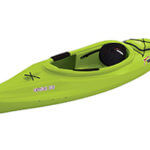
Example #1 – Cell Phone Case
Sales Price: $15.99
Referral Fee: $2.39
Amazon FBA Fees: $2.41
Net Revenue: $11.19
Example #2 – Flat Screen TV
Sales Price: $139.99
Referral Fee: $18.20
Amazon FBA Fees: $16.95
Net Revenue: $104.84
Example #3 – Full Sized Kayak
Sales Price: $235.99
Referral Fee: $35.40
Amazon FBA Fees: $137.32
Net Revenue: $63.27
How do Amazon FBA fees compare to Ebay fees?
Now the question becomes which is cheaper to sell on: Amazon FBA or Ebay? Both platforms have their own advantages and disadvantages certainly. And, to be honest, Ebay’s a little easier for a lot of people to understand.
But it is it more profitable to sell a product on Amazon or Ebay?
Let’s say that you’re a seller on both Amazon FBA and Ebay and you plan on selling 300 products per month at a price of $20.00 each. The product you sell is a small product, small enough to fit in a USPS small flat-rate box.
How do Amazon FBA Fees compare to Ebay fees?
If you are selling 300 products per month at $20.00 that weigh less than 1 lbs.
As you can see, the total Amazon fees to sell 300 products in a month at $20 each is nearly $1,000 less than it would cost to sell the same products on Ebay. Also, this doesn’t account for Ebay’s other small fees such as advanced listing upgrades.
Greg’s Tip #5
If you’re a hobby seller and don’t plan on selling more than a few dozen products per month, then Ebay may be a better option for you. In my opinion, selling via Amazon FBA is 100 times better than selling on Ebay.
If you’d like to learn more about Amazon vs Ebay check out this article.
5 more reasons why you should sell on Amazon FBA
Obviously, the advantages for Amazon seller fees versus Ebay fees are quite huge. But did you know that there’s other great reasons why you should sell on Amazon FBA vs selling on Ebay or any other ecommerce platform? Here’s five of my favorite reasons:
1 – Amazon FBA does most of the work for you.
With Amazon FBA, all you have to do is find the products and send them to one of Amazon’s fulfillment centers. From there, Amazon’s fulfillment center agents pick, pack, and ship your products on your behalf. Not only that, but they also handle customer service and returns for you as well. That means your job as an ecommerce entrepreneur is infinitely easier than it would be without that service.
2 – Amazon gets 2.64 billion customers shopping on their site per month.
Amazon spent the last 25 years building a brand reputation. And it’s paid off! Amazon receives 2.64 billion visits to just their US site each month. That’s more than twice the amount of traffic that Ebay gets!
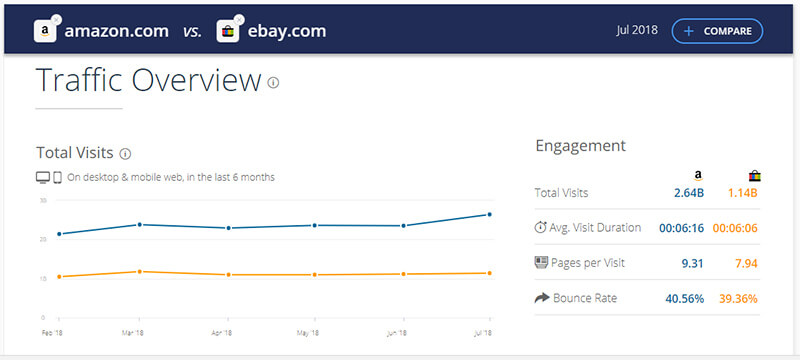
SimilarWeb data for Amazon vs Ebay July 2018
Now, that’s not even the craziest statistic. On Amazon, there are only 5 million sellers world-wide versus the 25 million Ebay sellers world wide. In fact, if you just take the Ebay sellers that consider themselves “professional” sellers, there’s still more than all of Amazon’s sellers combined at 6.7 million professional sellers worldwide.
Long story short: Amazon has a bigger market with fewer sellers than Ebay.
3 – You can estimate your Amazon sales before you even start selling.
Thanks to Amazon’s best-seller ranking data and powerful software like Jungle Scout, you can actually estimate the average sales for a particular product before you even start selling it. This helps you make decisions on whether or not you should carry a particular product.
For example, a product like a garlic press might sell over 500 units per month versus a set of book ends which might only sell 200 units per month. However, the garlic press may have too many competitors whereas the book ends have virtually none.
Let me show you how can you predict Amazon sales in 10 seconds or less.
First, go on Amazon and do a search for a product. I’m going to search for garlic presses.
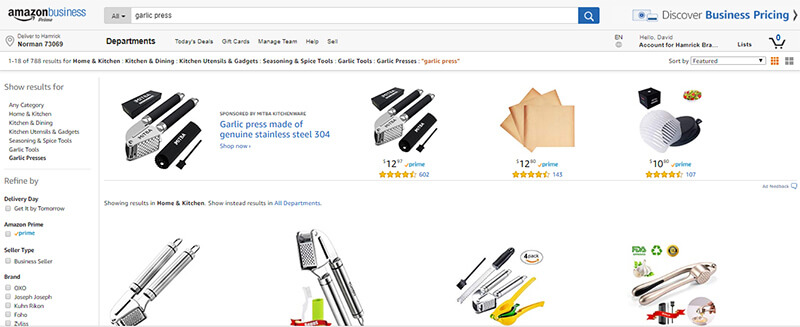
Next, I’m going to use the Jungle Scout Chrome Extension to estimate the average sales for garlic presses.
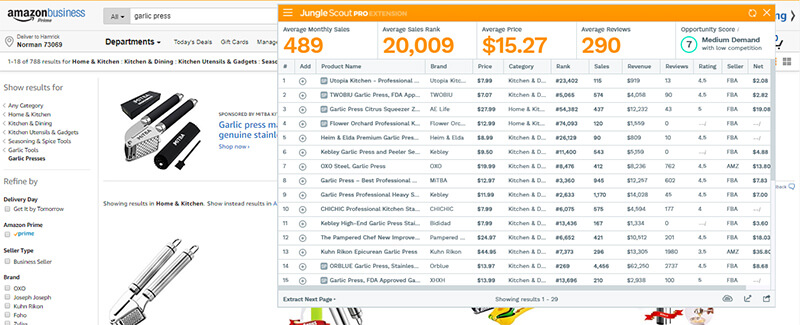
As you can see, a lot of cool data popped up. Let’s take a closer look at the results:
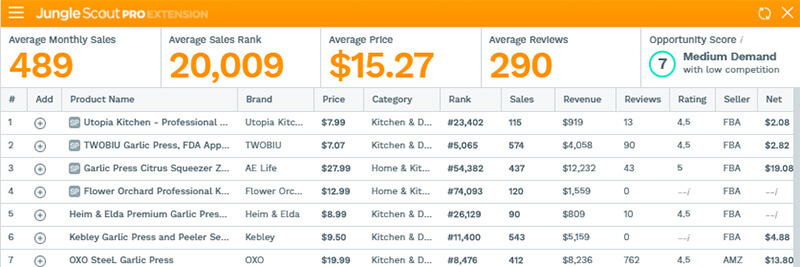
Here’s what we learned from garlic presses and the Jungle Scout Chrome Extension Pro:
- Garlic presses have an average of 489 sales per month.
- They sell for $15.27 each average.
- All sellers selling garlic presses have an average of 290 reviews each.
- The Jungle Scout Chrome Extension awards garlic presses an opportunity score of 7.
Pretty cool, right? Check out the Jungle Scout Chrome Extension below.
The Jungle Scout Chrome Extension.
4 – You create and control your own listing on Amazon.
While there are lots of branded and popular product listings that you can share with other sellers, when you create your own product on Amazon through a method called private label, you have 100% control over what goes into the listing. That includes title, description, images, and price. Furthermore, if your product is registered, nobody else can change your product.
5 – Amazon is scalable.
New millionaires are minted every year thanks to Amazon FBA. This is mostly because Amazon is scalable. Thanks to all of the aforementioned benefits to selling on Amazon–Amazon FBA warehousing, high consumer traffic, sales estimation software and listin gcontrol–it’s easy to grow your business from something as small as a garage business to a multi-million dollar empire.
How to start selling on Amazon FBA in 5 easy steps
Hopefully, you’re pretty excited about selling on Amazon now. Let me show you how you can get started selling on Amazon in just 5 easy steps:
1 – Create an Amazon seller account.
So long as you have a phone number and a bank account, setting up an Amazon seller account is easy. Simply go to Amazon Seller Registration and put in your information. Don’t worry, you can sign up for an individual account now and switch to a professional account later if you want to feel it out.
For more information on how to register, you can read this article: Amazon Seller Registration – A Step by Step Guide to Getting Started
2 – List a product to sell on Amazon.
FBA is definitely the prefered method of selling on Amazon, but you can also sell products and fulfill them directly from your home. In fact, I recommend you try this method first, to get a feel for what it’s like to sell something online. It can be anything, too. From books to kitchen products to even clothing and sportswear.
If you have more than one product to sell, then you might try shipping it to an Amazon Fulfillment Center for their FBA program.
3 – Learn more about private label.
To really enjoy a huge passive income on Amazon, we recommend you learn a little more about private label. it’s crazy easy to do. All you have to do is find a profitable product opportunity to sell on Amazon, source it with a manufacturer that already creates the product you’re looking for, and send it to Amazon FBA. It’s that simple!
In fact, we’ve taken the time to create a FREE training course to show you exactly how you can create your own products to sell on Amazon FBA.
4 – Sit back and watch your products sell.
Once your product is listed it should sell fast, especially if it’s a product that’s in high demand. If you sold via Amazon FBA–as in Amazon was holding your inventory for you–then all you will receive is a notification on your seller page that the product sold. If you sold from your own home, then you’ll need to print the shipping label and purchase shipping for it.
5 – Get paid.
Unlike Ebay where you get paid at the end of each transaction, with Amazon you’re paid every two weeks. And I love this because Amazon will take all relevant costs directly out of what I’m paid. Therefore, if I’m spending money on Amazon PPC ads or I need to pay my subscription fee, it’s all done in advance. Plus, it helps me budget and operate my business. And Amazon issues tax information, making tax time way easier.
Get started with Amazon FBA today.
Hopefully, this article on Amazon FBA fees and how you can still profit on Amazon showed you just how simple it is to get started with this amazing entrepreneurial opportunity.
If you’d like to learn more about selling on Amazon and the money that you can expect to make as an Amazon FBA seller, be sure to watch our FREE video course, How to Sell on Amazon FBA for Beginners.
